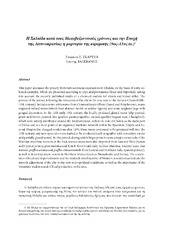| dc.description.abstract | This paper discusses the pottery from various rescue excavations in Chalcis, on the basis of some selected examples, which are presented according to type and provenance (local and imported), taking into account the recently published results of a chemical analysis (of sherds and tripod stilts). The pottery of the period, following the relocation of the city in the area next to the Euripos Channel (9th- 11th century), includes some whitewares from Constantinople (Plain Glazed and Polychrome), many unglazed incised wares (which bear abstract motifs or animal figures) and some unglazed jugs with gouged decoration. In the 12th-early 13th century, the locally produced glazed wares (slip-painted, green-and-brown painted, fine sgrafitto, painted sgraffito, incised sgraffito/Aegean ware, Champlevé), which were widely distributed around the Mediterranean, reflect the role of Chalcis as the main port of Hellas and as a focal point of an organized maritime network within the Byzantine Empire and beyond. Despite the changed conditions after 1204, these wares continued to be produced well into the 13th century, and new types also soon started to be produced (such as sgraffito with concentric circles and partially glazed wares). In this period, during which Negroponte became a major crossroads of the Venetian maritime network in the East, various wares were also imported from East and West (Syrian and Cypriot pottery, protomaiolica and R.M.R. from South Italy, Archaic Maiolica, ‘roulette’ ware, San Bartolo, graffita arcaica and graffita rinascimentale from Central and Northern Italy, Spanish pottery), as well as from important centres in Northern Greece (such as Thessaloniki and Serres). The coexistence of local and imported wares and the relatively small number of Western ceramics may indicate the smooth adjustment of the city to the new socio-political conditions, as well as the importance of the Byzantine tradition and of local production in the area. | nob |
